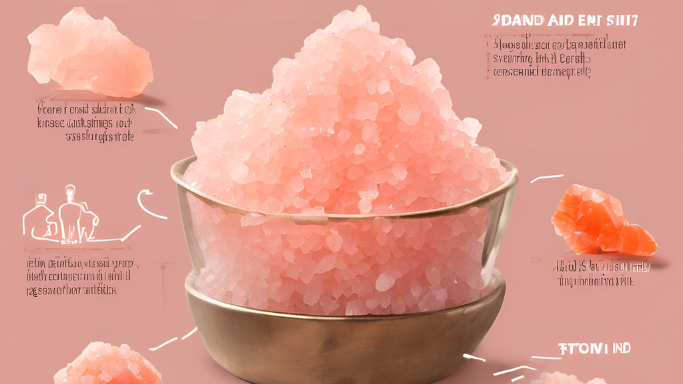Himalayan salt is one of the most sought-after salts in the world, not only for its culinary uses but also for its striking pink color. Unlike the common white salt that we typically see on dining tables, Himalayan salt has a beautiful pink hue, which makes it stand out. But what exactly causes this pink color, and why is Himalayan salt so special? Let's dive into the science behind it.
Mineral Composition: The Key to the Pink Color
The most prominent factor behind the pink color of Himalayan salt is its mineral composition. This salt is harvested from ancient sea beds in the Khewra Salt Mine in Pakistan, which is one of the largest and oldest salt mines in the world. Over millions of years, the salt deposits were buried under layers of rock, which caused the salt to form in unique ways, locking in a variety of minerals and elements from the surrounding environment.
Himalayan salt contains over 80 trace minerals, many of which are not found in regular table salt. While sodium chloride (NaCl) makes up the bulk of the salt, it is these additional minerals that give the salt its distinctive pink color. The most significant of these minerals is iron oxide, also known as rust.
Iron Oxide: The Primary Culprit
The pink hue of Himalayan salt is primarily due to the presence of iron oxide, a form of iron that is also responsible for the reddish-brown color of rust. When the salt crystals form in the mines, the iron present in the salt reacts with oxygen over time, creating this reddish tint. The more iron oxide in the salt, the more intense the pink color appears. This is why Himalayan salt can range in color from pale pink to deep reddish-pink or even maroon, depending on the concentration of minerals in each individual salt crystal.
Interestingly, Himalayan salt contains only trace amounts of iron compared to the iron found in food, which is why it doesn’t have any significant nutritional impact. However, it’s the aesthetic appeal of these mineral-rich salts that make them so popular, particularly for use in decorative salt lamps, cooking blocks, and artisanal dishes.
Other Minerals Contributing to the Color
In addition to iron oxide, other minerals in Himalayan salt contribute to its varying shades of pink. Some of these include:
Calcium: Calcium is often found in trace amounts in Himalayan salt. While it doesn’t significantly affect the color, calcium does play a role in the texture and mineral richness of the salt.
Magnesium: Magnesium is another mineral present in Himalayan salt, and like calcium, it contributes to the overall mineral profile, although its effect on color is minimal.
Potassium: Potassium, which is essential for proper bodily function, is also present in small amounts in Himalayan salt and may slightly influence its color.
Copper and Zinc: Both copper and zinc can add to the overall coloration of the salt, though their impact is less pronounced than that of iron.
These trace minerals, although not enough to drastically affect the color, contribute to the salt’s overall nutritional value and its natural, unrefined character.
Why Does the Color Vary?
The varying shades of pink in Himalayan salt are the result of how these minerals are distributed throughout the salt crystals. Some crystals may have a higher concentration of iron oxide, leading to deeper red or pink hues, while others might contain more calcium or magnesium, resulting in lighter shades. The deeper the color, the more mineral-rich the salt is, but even lighter shades of pink are packed with beneficial minerals.
Himalayan salt’s natural mineral content also helps preserve its purity. Unlike table salt, which is heavily processed and stripped of most trace minerals, Himalayan salt remains largely unrefined, preserving its unique qualities and contributing to its health benefits.
Himalayan Salt: More Than Just a Pretty Color
Beyond its eye-catching pink hue, Himalayan salt offers a variety of health benefits due to its mineral content. It is often touted for being less processed than table salt, which typically contains additives like iodine and anti-caking agents. As a result, Himalayan salt is considered by some to be a healthier alternative, though it’s important to note that both types of salt contain similar amounts of sodium.
In cooking, Himalayan salt is used not just for its flavor but also for its visual appeal. It is commonly found in cooking blocks, where it imparts a subtle flavor and beautiful presentation. Additionally, Himalayan salt is often used in decorative lamps and salt crystals, which are believed to have air-purifying properties due to the natural moisture absorption of the crystals. While more research is needed to confirm these benefits, many people enjoy the aesthetic value and calming atmosphere that Himalayan salt lamps create in their homes.
Conclusion
The pink color of Himalayan salt is due to the presence of iron oxide, along with other trace minerals like magnesium, calcium, potassium, and zinc. These minerals contribute to the salt’s vibrant color and its health benefits. Whether used in cooking, for therapeutic purposes, or as a decorative piece, Himalayan salt’s natural beauty and mineral richness make it a valuable addition to many kitchens and households. While its pink hue is certainly eye-catching, the real magic of Himalayan salt lies in its rich, unrefined composition that offers a connection to the earth’s ancient mineral deposits.




